Cost-Effective Encryption-Based Autonomous Routing Protocol for Efficient and Secure Wireless Sensor Networks
Abstract
:1. Introduction
- By incorporating a random key encryption and decryption mechanism [26] into BIOSARP, we propose an enhanced BIOSARP named E-BIOSARP to provide overall network communication security from the very beginning of the establishment of a WSN at a low performance cost.
- Our security analysis shows that E-BIOSARP can ensure confidentiality and integrity by encrypting header fields such as the packet sequence ID (Pkt_ID), destination ID (D_ID), and source ID (S_ID) and by transmitting fragmented data instead of applying cryptographic operations to complete packets, as is the case in most security mechanisms.
- Our security analysis also shows that E-BIOSARP is resilient against data tampering attacks, selective forwarding, brute-force or exhaustive key search, spoofing, eavesdropping, replaying or altering of routing information, cloning, acknowledgment spoofing, HELLO flood attacks, and Sybil attacks.
- We present the implementation of a WSN scenario using E-BIOSARP in network simulator 2 (ns-2) and the population of this scenario with malicious nodes to analyze the behavior and performance of E-BIOSARP.
- E-BIOSARP is analytically and experimentally compared in terms of processing time with state-of-the-art security mechanisms, including TinyHash, TinySec with authenticated encryption (TinySec-AE), TinySec with authentication only (TinySec-Auth), exclusion basis systems (EBSs), location-based resilient security with authentication (LBRS-Auth), and SRTLD.
- Simulation results show that E-BIOSARP outperforms SRTLD in terms of energy consumption, packet overhead and delivery ratio and also outperforms another state-of-the-art secure routing protocol, the energy-efficient secure path algorithm (ESPA), in terms of energy consumption.
2. Related Work
3. The Architecture of the Proposed E-BIOSARP
- Two master keys (k1 and k) generated with a pseudo-random function are injected into each sensor node while it is flashing its read-only memory (ROM). Here, k1 is a master key for the new node, and k is a master key for all nodes.
- Before deployment, every node is set with a hard mathematical function and its reverse computation.
4. Security Analysis
- Attack based on packet dropping: The proposed encryption mechanism rapidly identifies and only replies to and/or forwards data packets to self-nodes. The authentication process is fast because of the reduced overhead of the proposed encryption mechanism, as elaborated in Section 3, and thus can efficiently handle packet drop attacks.
- Node replication or cloning attack: This type of attack is initiated when an adversary takes the complete information of a node, replicates/clones a node with the same information, and inserts the clone into the network to execute further attacks. E-BIOSARP protects the network from remote node replication or cloning attacks by rapidly identifying non-self/compromised nodes and thus avoids the receiving or sending of any packet from or to such a node.
- Brute-force search (or exhaustive key search attack): In a brute-force search attack, the adversary attempts to acquire a user ID and password. The proposed encryption mechanism uses a random key (Pkt_ID and k) that changes at the processing of every packet. Furthermore, E-BIOSARP’s rapid identification process makes it extremely difficult for an attacker to acquire the fragmented data or, if they are acquired, to reconstitute them [29].
- Eavesdropping attack: The random-key-based encryption mechanism avoids eavesdropping attacks by encrypting the main contents S_ID and D_ID of the communication; thus, monitoring is secret, and hijacking of confidential data is impossible.
- Altered, spoofed, or replayed routing information attack or wormhole attack: In this type of attack, the adversary or malicious node targets the routing information exchanged between nodes. The rapid authentication process in E-BIOSARP protects the network from these types of attacks by protecting the packet header. Therefore, when a sensor node transmits a packet, it encrypts the header, and upon receipt, the proposed mechanism confirms that certain fields are encrypted with the correct key. If not, the packet is dropped without being opened, as shown in Figure 6.
- Acknowledgment spoofing and selective forwarding: A malicious node executes this type of attack by receiving and dropping packets as they travel through the network; as a result, the nodes at one hop conclude that there is a problem with the forwarding of data packets through the nodes in the routing table. Alternatively, a malicious node may use feedback to alter a node’s decision regarding which strong link to use to send packets. The fast authentication process in E-BIOSARP protects the WSN from acknowledgment spoofing and selective forwarding attacks by rapidly identifying and dropping non-self packets, as shown in Figure 6.
- Sybil attack: In a Sybil attack, a malicious node begins advertising itself with multiple IDs. When a self-node receives these RTR packets, they cannot be authenticated because of their different header structure and/or field values, and they are consequently dropped, as presented in Figure 6.
- HELLO flood attack: An invader deploys a strong device that generates and broadcasts RTR/HELLO packets with a high signal strength to convince the WSN nodes that the adversary node is a neighboring self-node. Under E-BIOSARP, the possibility of forwarding data to such non-self or HELLO-flood-generated nodes is avoided through the dropping of these false packets.
5. Complexity Analysis
6. Simulation-Based Implementation, Experimental Results and Discussion
6.1. Simulation of Abnormalities and Attack Countermeasures
6.2. Impact of an Increasing Number of Malicious Nodes
6.3. Processing Time Comparison
- : time of packet dispatch from the sending node with the security scheme.
- : time of packet reception at the receiving node with the security scheme.
- : time of packet dispatch from the sending node without the security scheme.
- : time of packet reception at the receiving node without the security scheme.
6.4. Delivery Ratio Comparison of E-BIOSARP, BIOSARP and SRTLD
6.5. Energy Consumption Comparison for E-BIOSARP, BIOSARP and SRTLD
6.6. Packet Overhead Comparison between E-BIOSARP, BIOSARP and SRTLD
6.7. Detection Rate and Accuracy Comparison between E-BIOSARP and SRTLD
6.8. Comparative Analysis of E-BIOSARP and ESPA
7. Concluding Remarks
Acknowledgments
Author Contributions
Conflicts of Interest
References
- Cerpa, A.; Wong, J.L.; Kuang, L.; Potkonjak, M.; Estrin, D. Statistical model of lossy links in wireless sensor networks. In Proceedings of the Fourth International Symposium on Information Processing in Sensor Networks, ACM/IEEE IPSN, Los Angeles, CA, USA, 25–27 April 2005; pp. 81–88.
- Saleem, K. Biological Inspired Self-Organized Secure Autonomous Routing Protocol for Wireless Sensor Networks. Ph.D. Thesis, Universiti Teknologi Malaysia, Johor Bahru, Malaysia, 2011. [Google Scholar]
- Butun, I.; Morgera, S.D.; Sankar, R. A survey of intrusion detection systems in wireless sensor networks. IEEE Commun. Surv. Tutor. 2014, 16, 266–282. [Google Scholar] [CrossRef]
- Chen, C.-Y.; Chao, H.-C. A survey of key distribution in wireless sensor networks. Secur. Commun. Netw. 2014, 7, 2495–2508. [Google Scholar] [CrossRef]
- Han, G.; Jiang, J.; Shu, L.; Niu, J.; Chao, H.-C. Management and applications of trust in wireless sensor networks: A survey. J. Comput. Syst. Sci. 2014, 80, 602–617. [Google Scholar] [CrossRef]
- Fadlullah, Z.M.; Taleb, T.; Vasilakos, A.V.; Guizani, M.; Kato, N. DTRAB: Combating against attacks on encrypted protocols through traffic-feature analysis. IEEE/ACM Trans. Netw. 2010, 18, 1234–1247. [Google Scholar] [CrossRef]
- He, D.; Chen, C.; Chan, S.; Bu, J.; Vasilakos, A.V. ReTrust: Attack-resistant and lightweight trust management for medical sensor networks. IEEE Trans. Inf. Technol. Biomed. 2012, 16, 623–632. [Google Scholar] [PubMed]
- Saleem, S.; Ullah, S.; Kwak, K.S. A study of IEEE 802.15.4 security framework for wireless body area networks. Sensors 2011, 11, 1383–1395. [Google Scholar] [CrossRef] [PubMed]
- Silva, B.M.; Rodrigues, J.J.; Canelo, F.; Lopes, I.C.; Zhou, L. A data encryption solution for mobile health apps in cooperation environments. J. Med. Internet Res. 2013, 15. [Google Scholar] [CrossRef] [PubMed]
- Liu, B.; Bi, J.; Vasilakos, A.V. Toward incentivizing anti-spoofing deployment. IEEE Trans. Inf. Forensics Secur. 2014, 9, 436–450. [Google Scholar] [CrossRef]
- Ali, M.; Khan, S.U.; Vasilakos, A.V. Security in cloud computing: Opportunities and challenges. Inf. Sci. 2015, 305, 357–383. [Google Scholar] [CrossRef]
- Rawat, P.; Singh, K.D.; Chaouchi, H.; Bonnin, J.M. Wireless sensor networks: A survey on recent developments and potential synergies. J. Supercomput. 2013, 68, 1–48. [Google Scholar] [CrossRef]
- Walters, J.P.; Liang, Z. Wireless sensor network security: A survey. In Security in Distributed Grid, Mobile, and Pervasive Computing; Yang, X., Ed.; CRC Press: Boca Raton, FL, USA, 2007; pp. 368–403. [Google Scholar]
- Saleem, K.; Derhab, A.; Al-Muhtadi, J.; Shahzad, B.; Orgun, M.A. Secure transfer of environmental data to enhance human decision accuracy. Comput. Hum. Behav. 2015, 51, 632–639. [Google Scholar] [CrossRef]
- Karlof, C.; Wagner, D. Secure routing in wireless sensor networks: Attacks and countermeasures. Ad Hoc Netw. 2003, 1, 293–315. [Google Scholar] [CrossRef]
- Pathan, A.K.; Lee, H.W.; Hong, C.S. Security in wireless sensor networks: Issues and challenges. In Proceedings of the 8th IEEE ICACT 2006, Phoenix Park, Korea, 20–22 February 2006; pp. 1043–1048.
- Chen, D.; Varshney, P.K. Geographic routing in wireless Ad Hoc networks. In Guide to Wireless Ad Hoc Networks; Misra, S., Woungang, I., Eds.; Springer: London, UK, 2009; pp. 151–188. [Google Scholar]
- Sookhak, M.; Akhundzada, A.; Sookhak, A.; Eslaminejad, M.; Gani, A.; Khurram Khan, M.; Li, X.; Wang, X. Geographic wormhole detection in wireless sensor networks. PLoS ONE 2015, 10. [Google Scholar] [CrossRef]
- Junqi, Z.; Shankaran, R.; Orgun, M.A.; Varadharajan, V.; Sattar, A. A trust management architecture for hierarchical wireless sensor networks. In Proceedings of the 2010 IEEE 35th Conference on Local Computer Networks (LCN), Denver, CO, USA, 10–14 October 2010; pp. 264–267.
- Eigen, M.; Schuster, P. The Hypercycle: A Principle of Natural Self Organization; Springer-Verlag: Berlin, Germany, 1979. [Google Scholar]
- Von Foerster, H. On self-organizing systems and their environments. In Self-Organizing Systems; Yovitts, M.C., Cameron, S., Eds.; Pergamon Press: New York, NY, USA, 1960; pp. 31–50. [Google Scholar]
- Dressler, F. Benefits of bio-inspired technologies for networked embedded systems: An overview. In Dagstuhl Seminar Proceedings, Organic Computing—Controlled Emergence; Internationales Begegnungs—Und Forschungszentrum fur Informatik (IBFI): Schloss Dagstuhl, Germany, 2006; pp. 1–17. [Google Scholar]
- Saleem, K.; Fisal, N.; Abdullah, M.S.; Ariffin, S.H.S. Biological inspired secure autonomous routing mechanism for wireless sensor networks. Int. J. Intell. Inf. Database Syst. 2011, 5, 313–337. [Google Scholar] [CrossRef]
- Saleem, K.; Fisal, N.; Baharudin, M.A.; Ahmed, A.A.; Hafizah, S.; Kamilah, S. BIOSARP—Bio-inspired self-optimized routing algorithm using ant colony optimization for wireless sensor network—Experimental performance evaluation. In Computers and Simulation in Modern Science, Included in ISI/SCI Web of Science and Web of Knowledge; Mastorakis, N.E., Demiralp, M., Mladenov, V.M., Eds.; WSEAS Press: Sofia, Bulgaria, 2011; pp. 165–175. [Google Scholar]
- Saleem, K.; Fisal, N.; Hafizah, S.; Rashid, R. An intelligent information security mechanism for the network layer of WSN: BIOSARP. In Computational Intelligence in Security for Information Systems; Herrero, Á., Corchado, E., Eds.; Springer: Berlin/Heidelberg, Germany; pp. 118–126.
- Ahmed, A.A.; Fisal, N.F. Secure real-time routing protocol with load distribution in wireless sensor networks. Secur. Commun. Netw. 2011, 4, 839–869. [Google Scholar] [CrossRef]
- Saleem, K.; Khalil, M.S.; Fisal, N.; Ahmed, A.A.; Orgun, M.A. Efficient random key based encryption system for data packet confidentiality in WSNs. In Proceedings of the IEEE International Conference on Trust, Security and Privacy in Computing and Communications (TrustCom2013), Melbourne, Australia, 16–18 July 2013; pp. 1662–1668.
- Lim, C.H. LEAP++: A robust key establishment scheme for wireless sensor networks. In Proceedings of the 28th International Conference on Distributed Computing Systems Workshops, Beijing, China, 17–20 June 2008; pp. 376–381.
- Jean de Dieu, I.; Assouma, N.; Muhamad, M.; Jin, W.; Lee, S. Energy-efficient secure path algorithm for wireless sensor networks. Int. J. Distrib. Sens. Netw. 2012, 2012, 1–11. [Google Scholar] [CrossRef]
- Wang, H.; Sheng, B.; Tan, C.C.; Li, Q. Comparing symmetric-key and public-key based security schemes in sensor networks: A case study of user access control. In Proceedings of the 28th International Conference on Distributed Computing Systems, Beijing, China, 17–20 June 2008; pp. 11–18.
- Faisal, M.; Al-Muhtadi, J.; Al-Dhelaan, A. Integrated protocols to ensure security services in wireless sensor networks. Int. J. Distrib. Sens. Netw. 2013, 2013, 1–13. [Google Scholar] [CrossRef]
- Pathan, A.-S.K.; Hong, C.S. SERP: Secure energy-efficient routing protocol for densely deployed wireless sensor networks. Ann. Telecommun. 2008, 63, 529–541. [Google Scholar] [CrossRef]
- Lasla, N.; Derhab, A.; Ouadjaout, A.; Bagaa, M.; Challal, Y. SMART: Secure multi-paths routing for wireless sensor networks. In Ad-Hoc, Mobile, and Wireless Networks; Guo, S., Lloret, J., Manzoni, P., Ruehrup, S., Eds.; Springer International Publishing: Berlin, Germany, 2014; pp. 332–345. [Google Scholar]
- Saleem, K.; Fisal, N.; Al-Muhtadi, J. Empirical studies of bio-inspired self-organized secure autonomous routing protocol. IEEE Sens. J. 2014, 14, 2232–2239. [Google Scholar] [CrossRef]
- Saleem, K.; Fisal, N.; Baharudin, M.A.; Ahmed, A.A.; Hafizah, S.; Kamilah, S. Ant colony inspired self-optimized routing protocol based on cross layer architecture for wireless sensor networks. WSEAS Trans. Commun. 2010, 9, 669–678. [Google Scholar]
- Saleem, K.; Fisal, N. Enhanced ant colony algorithm for self-optimized data assured routing in wireless sensor networks. In Proceedings of the 2012 18th IEEE International Conference on Networks (ICON), Singapore, Singapore, 12–14 December 2012; pp. 422–427.
- Zhang, Y.; Kumar, N.; Chen, J.; Rodrigues, J.J.P.C. A secure energy-efficient access control scheme for wireless sensor networks based on elliptic curve cryptography. Secur. Commun. Netw. 2015. [Google Scholar] [CrossRef]
- Fu, J.S.; Liu, Y. Double cluster heads model for secure and accurate data fusion in wireless sensor networks. Sensors 2015, 15, 2021–2040. [Google Scholar] [CrossRef] [PubMed]
- Li, X.; Chen, D.; Li, C.; Wang, L. Secure data aggregation with fully homomorphic encryption in large-scale wireless sensor networks. Sensors 2015, 15, 15952–15973. [Google Scholar] [CrossRef] [PubMed]
- Rahayu, T.M.; Lee, S.G.; Lee, H.J. A secure routing protocol for wireless sensor networks considering secure data aggregation. Sensors 2015, 15, 15127–15158. [Google Scholar] [CrossRef] [PubMed]
- Sanzgiri, K.; Dahill, B.; Levine, B.N.; Shields, C.; Royer, E.M.B. A secure routing protocol for Ad Hoc networks. In Proceedings of the 10th IEEE International Conference on Network Protocols, Paris, France, 12–15 November 2002; pp. 78–87.
- Schneier, B. Applied Cryptography: Protocols, Algorithms, and Source Code in C, 2nd ed.; John Wiley & Sons, Inc.: New York, NY, USA, 1995. [Google Scholar]
- Xiao, S.; Gong, W.; Towsley, D. Dynamic wireless security. In Dynamic Secrets in Communication Security; Springer: New York, NY, USA, 2014; pp. 33–53. [Google Scholar]
- Saleem, K.; Derhab, A.; Al-Muhtadi, J.; Orgun, M.A. Analyzing ant colony optimization based routing protocol against the hole problem for enhancing user’s connectivity experience. Comput. Hum. Behav. 2015, 51, 1340–1350. [Google Scholar] [CrossRef]
- Liu, S.; Gavrylyako, O.V.; Bradford, P.G. Implementing the TEA algorithm on sensors. In Proceedings of the 42nd Annual Southeast Regional Conference, Huntsville, AL, USA, 2–3 April 2004; pp. 64–69.
- Camilo, T.; Carreto, C.; Silva, J.; Boavida, F. An energy-efficient ant-based routing algorithm for wireless sensor networks. In Ant Colony Optimization and Swarm Intelligence; Dorigo, M., Ed.; Springer: Berlin, Germany, 2006; pp. 49–59. [Google Scholar]


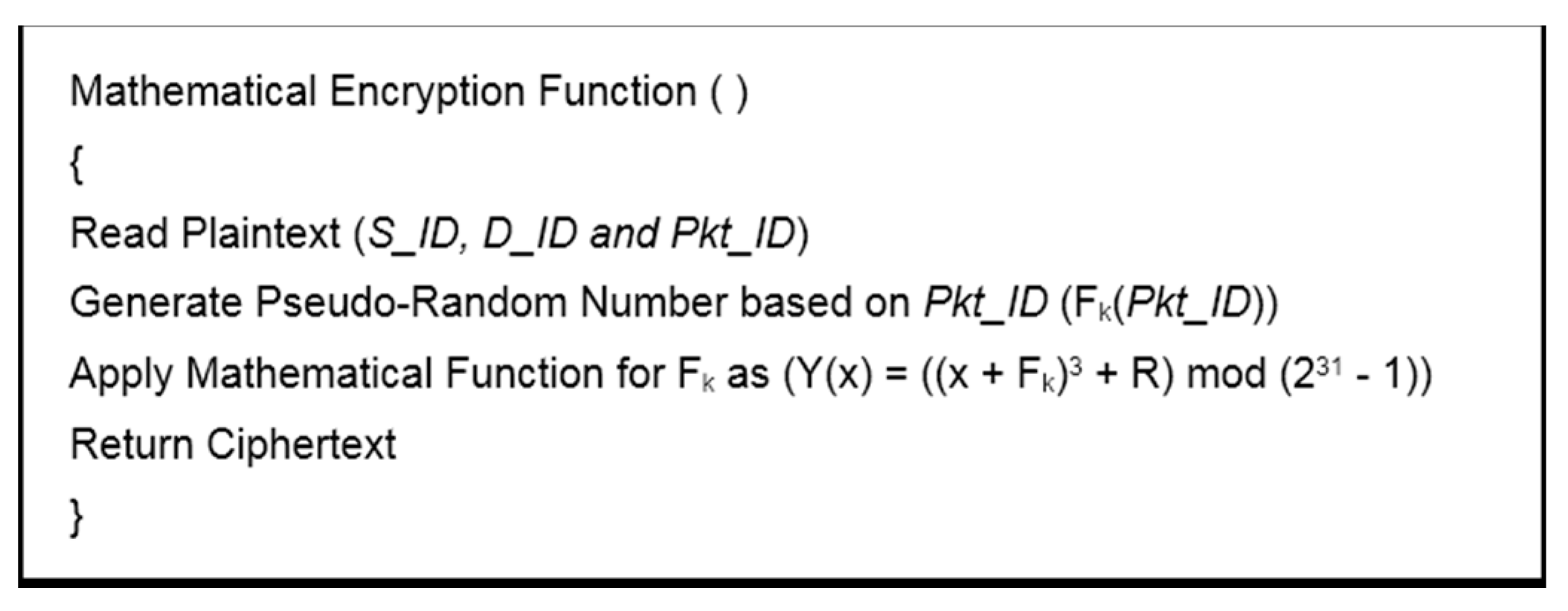


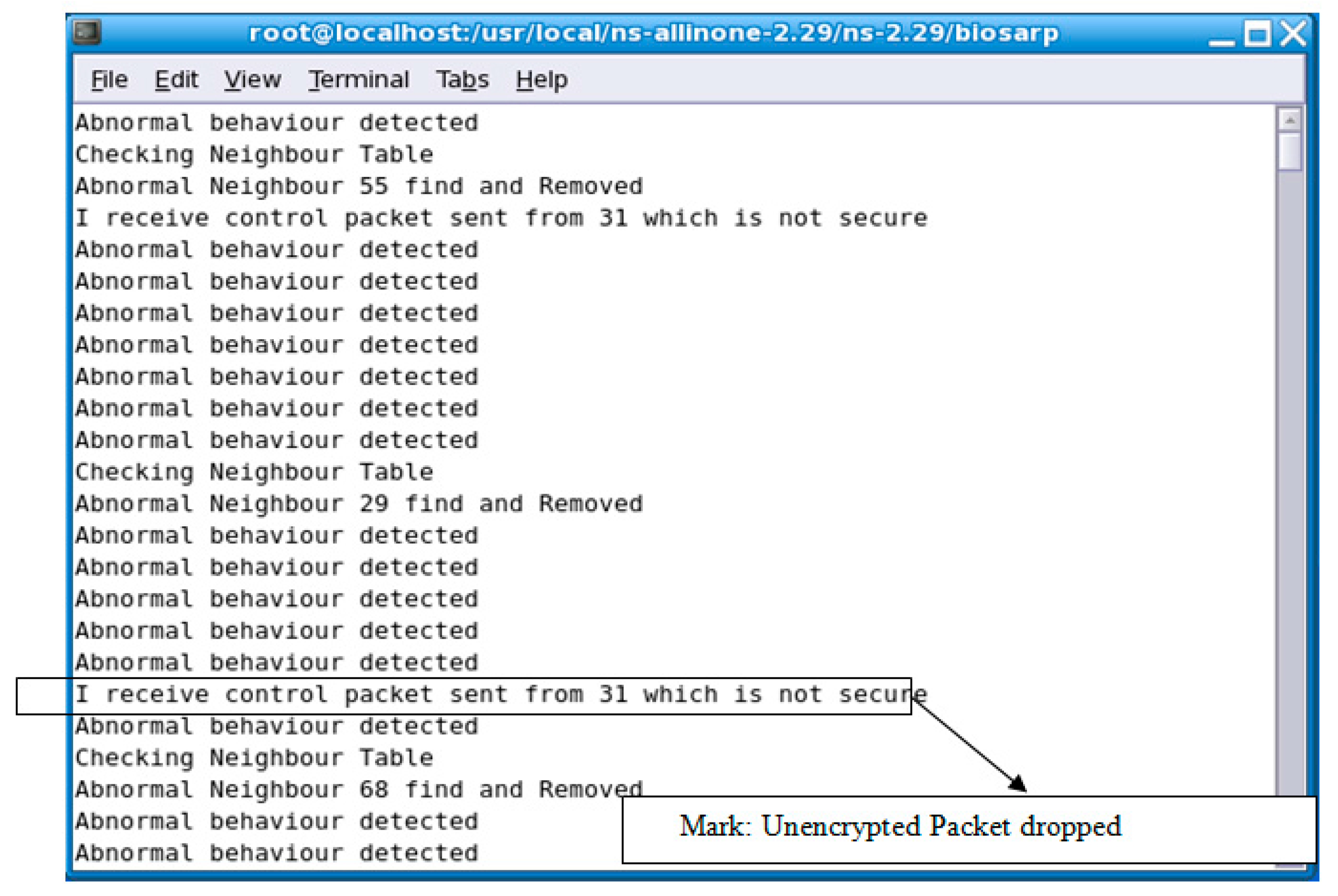
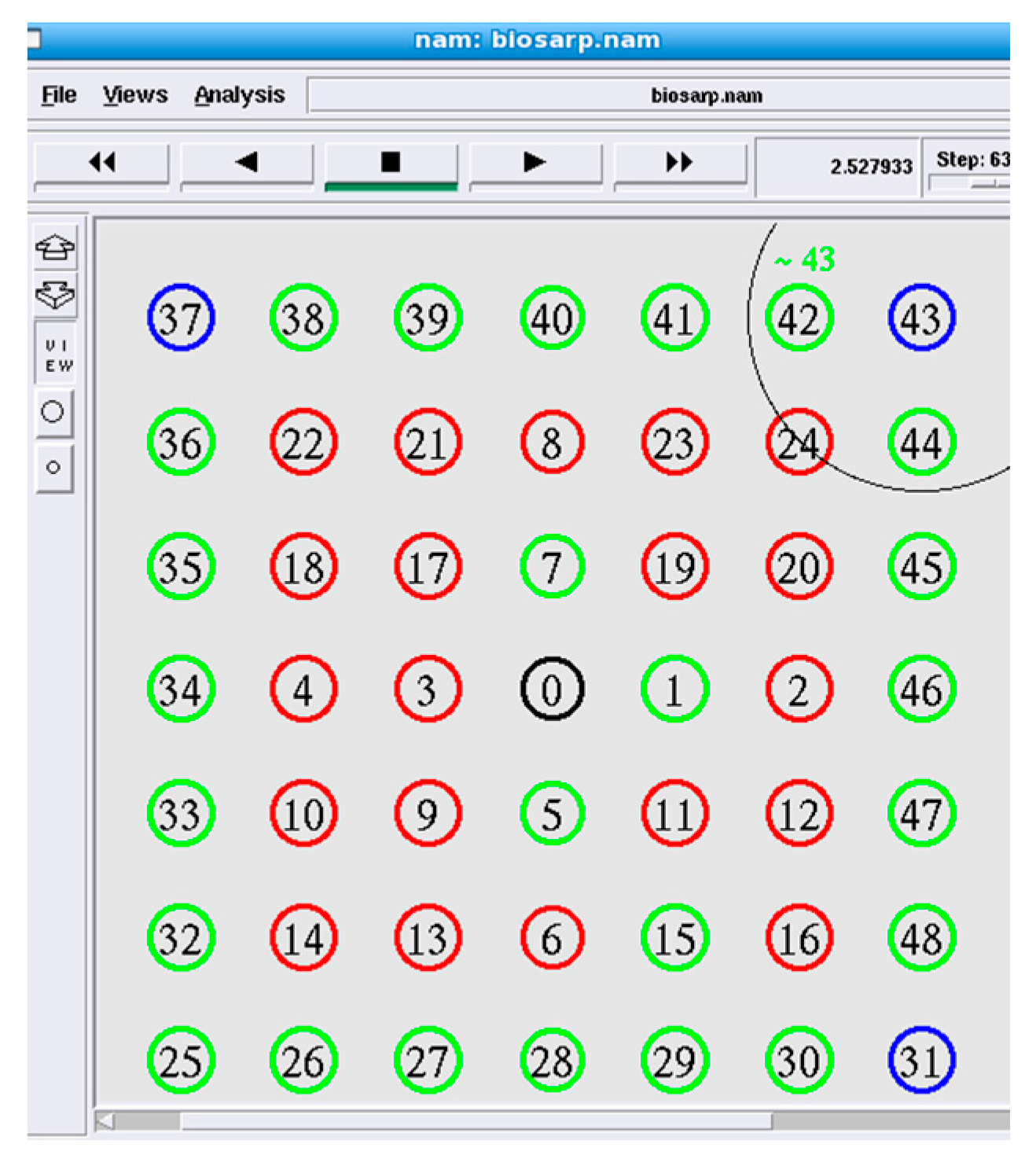




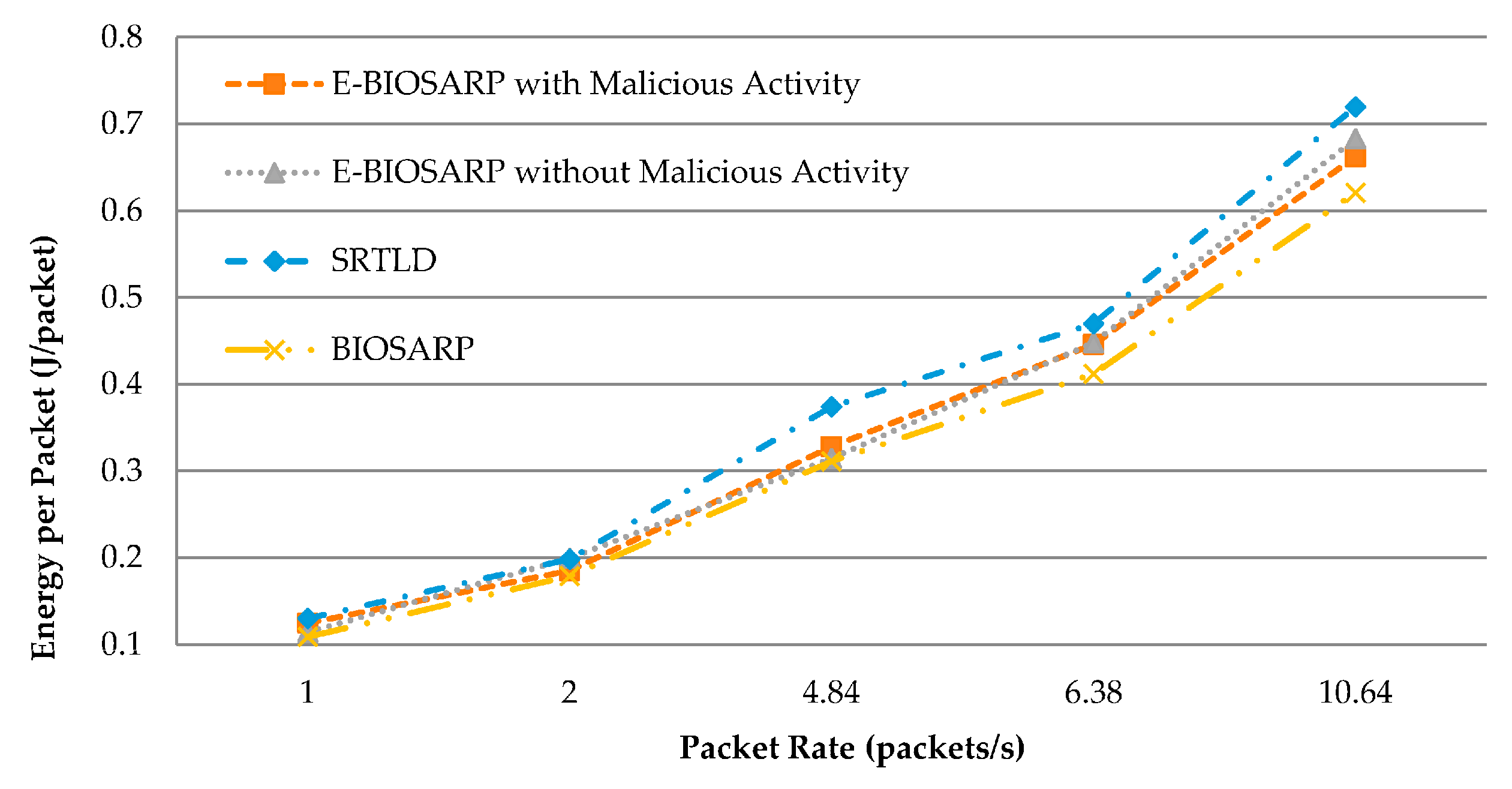
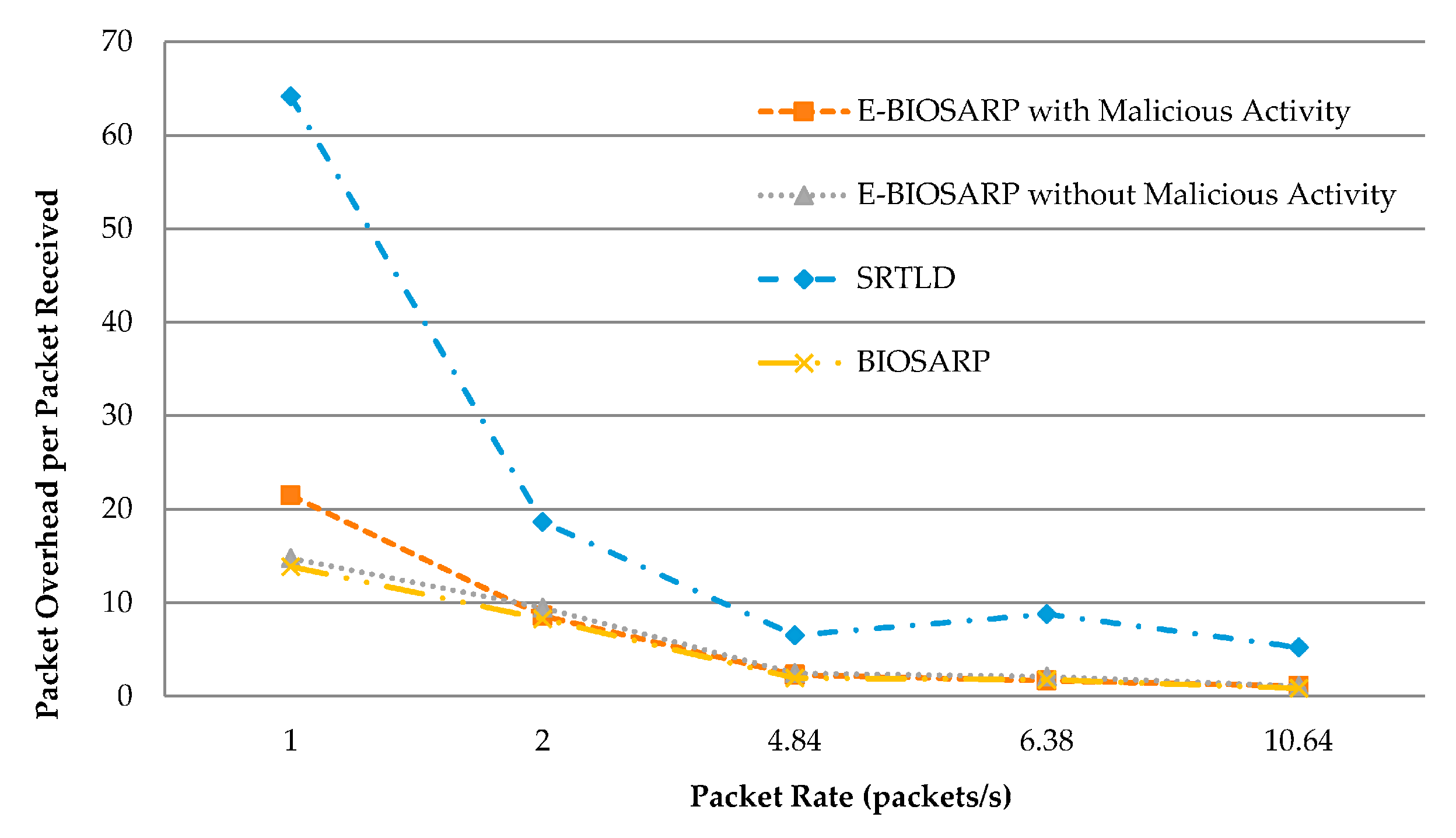

| Related Work | Attacks Covered | Shortcomings/Limitations |
|---|---|---|
| SERP [32] | Heavy flooding attacks | The shared secret key is pre-stored. The secret key is preloaded and is not self-maintained by the system in real time. The source node ID is readable. The system is vulnerable to brute-force search and eavesdropping attacks. |
| SRTLD [26] | Selective forwarding attacks Sinkhole attacks HELLO flood attacks Sybil attacks Wormhole attacks | The parameter weights for routing optimization must be re-evaluated according to location. Every sensor node in the WSN is programmed with a static location. The sink node is assumed to be a trusted base station. |
| ESPA [29] | Brute-force search attacks Denial of service attacks | The main commands are generated from a centralized location. Massive traffic overhead consumes an enormous amount of energy over the network. The network collapses when and where key information is not shared. |
| BIOSARP [23,27] | Sybil attacks Selective forwarding attacks Replayed or altered routing information attacks Acknowledgment spoofing attacks HELLO flood attacks | Not tested for unknown attacks. Needs to be tested on a real experimental WSN test bed including all attacks. |
| DCHM [38] | Jamming attacks Falsification of local values Falsification of fusion | The need for a trust system and feedback from the base station to the cluster heads generates enormous data packet overhead. Assumes that the base station is a trusted computing platform. The cluster key is unique for every cluster, increasing complexity. Has not been compared with any state-of-the-art security algorithm. |
| DWGRP [18] | Wormhole attacks | Beacon packets are broadcasted with unencrypted information. Nodes rebroadcast at an interval of 0.3 s. Very costly because the nodes require a GPS. |
| Security Scheme | Security Functions | Ranking of the Scheme |
|---|---|---|
| TinyHash | Encrypt(D) + MAC(D) | 5 |
| TinySec-AE | Encrypt(P) + MAC(D) | 4 |
| TinySec-Auth | MAC(D) | 3 |
| LBRS-Auth and EBSS | MAC(P) | 2 |
| SRTLD and E-BIOSARP | Encrypt(S_ID + D_ID + Pkt_ID) | 1 |
| Low-rate WPAN | IEEE 802.15.4 |
| Physical type | Phy/WirelessPhy/802_15_4 |
| MAC type | Mac/802_15_4 |
| Propagation model | Shadowing |
| Acknowledgment | Yes |
| Operation mode | Unslotted Non Beacon |
| Frequency | 2.4 GHz |
| Initial energy | 3.3 J |
| Power transmission | 1 mW |
| CSThresh_ | 1.10765 × 10−11 Hz |
| RXThresh_ | 1.10765 × 10−11 Hz |
| Traffic utilized | Constant Bit Rate (CBR) with Packet Size 70 bytes |
| Transport layer | User Datagram Protocol (UDP) |
| Simulation duration | 100 s |
| Adversary Nodes | Delivery Ratio | Energy per Packet (J/Packet) |
|---|---|---|
| 4 | 0.5322 | 0.0893563 |
| 8 | 0.4963 | 0.089909 |
| 12 | 0.54358 | 0.14805 |
| 16 | 0.5163 | 0.0891 |
| 20 | 0.251497 | 0.26612 |
| Adversary Nodes | Detection Rate and Accuracy in Percentage | |
|---|---|---|
| SRTLD | E-BIOSARP | |
| 4 | 6/25 = 24% | 14/18 = 78% |
| 8 | 20/34 = 58.82% | 18/22 = 82% |
| 12 | 37/45 = 82% | 43/51 = 84.3% |
| 16 | 64/86 = 74.42% | 67/84 = 79.762% |
| 20 | 498/572= 87.1% | 650/662 = 98% |
| Packet Rate (Packets/s) | E-BIOSARP without Malicious Nodes | E-BIOSARP with Malicious Nodes | BIOSARP without Malicious Nodes | SRTLD without Malicious Nodes |
|---|---|---|---|---|
| 1 | 0.536667 | 0.49 | 0.5453 | 0.3833 |
| 2 | 0.58345 | 0.553512 | 0.59838 | 0.523411 |
| 4.84 | 0.6964 | 0.658167 | 0.7054 | 0.625 |
| 6.38 | 0.75 | 0.68094 | 0.7528 | 0.6204 |
| 10.64 | 0.7052 | 0.65424 | 0.7154 | 0.61167 |
| Average | 0.6543434 | 0.6073718 | 0.663456 | 0.552756 |
| Packet Rate (Packets/s) | E-BIOSARP without Malicious Nodes | E-BIOSARP with Malicious Nodes | BIOSARP without Malicious Nodes | SRTLD without Malicious Nodes |
|---|---|---|---|---|
| 1 | 0.1142 | 0.1245 | 0.1087 | 0.13 |
| 2 | 0.19953 | 0.185057 | 0.1789 | 0.19856 |
| 4.84 | 0.314607 | 0.32807 | 0.3113 | 0.374 |
| 6.38 | 0.44784 | 0.4458 | 0.41201 | 0.47 |
| 10.64 | 0.68321 | 0.6625 | 0.62102 | 0.72 |
| Average | 0.3518774 | 0.3491854 | 0.326386 | 0.378512 |
| Packet Rate (Packets/s) | E-BIOSARP without Malicious Nodes | E-BIOSARP with Malicious Nodes | BIOSARP without Malicious Nodes | SRTLD without Malicious Nodes |
|---|---|---|---|---|
| 1 | 14.7702 | 21.483 | 13.875 | 64.1652 |
| 2 | 9.483 | 8.60725 | 8.274 | 18.65 |
| 4.84 | 2.473 | 2.283 | 1.952 | 6.543 |
| 6.38 | 2.1063 | 1.6626 | 1.7739 | 8.8 |
| 10.64 | 1.097 | 1.1053 | 0.849 | 5.22307 |
| Average | 5.9859 | 7.02823 | 5.34478 | 20.676254 |
| Packet Rate (Packets/s) | Detection Rate and Accuracy in Percentage | ||
|---|---|---|---|
| SRTLD | E-BIOSARP | Difference | |
| 1 | 85/110 = 77.3% | 109/128 = 85.2% | 7.9% |
| 2 | 128/161 = 79.5% | 137/154 = 89% | 9.5% |
| 4.84 | 196/243 = 81% | 134/151 = 88.74% | 7.74% |
| 6.38 | 187/239 = 78.24% | 140/151 = 92.72% | 14.48% |
| 10.64 | 144/176 = 82% | 411/429 = 95.8% | 13.8% |
| Average Accuracy | 79.608% | 90.292% | 10.684% |
| Packet Rate (Packets/s) | E-BIOSARP | ESPA | Difference |
|---|---|---|---|
| 12 | 99.7 | ||
| 48 | 98.9 | 97 | 1.9 |
| 88 | 96.9 | 94.3 | 2.6 |
| 150 | 96.5 | 93.5 | 3 |
| 250 | 95 | 89 | 6 |
| 300 | 94.5 | 87.5 | 7 |
| 460 | 93.4 | 81 | 12.4 |
| 636 | 91.7 | 71 | 20.7 |
| 785 | 89 | ||
| Average | 7.6571429 |
© 2016 by the authors; licensee MDPI, Basel, Switzerland. This article is an open access article distributed under the terms and conditions of the Creative Commons by Attribution (CC-BY) license (http://creativecommons.org/licenses/by/4.0/).
Share and Cite
Saleem, K.; Derhab, A.; Orgun, M.A.; Al-Muhtadi, J.; Rodrigues, J.J.P.C.; Khalil, M.S.; Ali Ahmed, A. Cost-Effective Encryption-Based Autonomous Routing Protocol for Efficient and Secure Wireless Sensor Networks. Sensors 2016, 16, 460. https://doi.org/10.3390/s16040460
Saleem K, Derhab A, Orgun MA, Al-Muhtadi J, Rodrigues JJPC, Khalil MS, Ali Ahmed A. Cost-Effective Encryption-Based Autonomous Routing Protocol for Efficient and Secure Wireless Sensor Networks. Sensors. 2016; 16(4):460. https://doi.org/10.3390/s16040460
Chicago/Turabian StyleSaleem, Kashif, Abdelouahid Derhab, Mehmet A. Orgun, Jalal Al-Muhtadi, Joel J. P. C. Rodrigues, Mohammed Sayim Khalil, and Adel Ali Ahmed. 2016. "Cost-Effective Encryption-Based Autonomous Routing Protocol for Efficient and Secure Wireless Sensor Networks" Sensors 16, no. 4: 460. https://doi.org/10.3390/s16040460
APA StyleSaleem, K., Derhab, A., Orgun, M. A., Al-Muhtadi, J., Rodrigues, J. J. P. C., Khalil, M. S., & Ali Ahmed, A. (2016). Cost-Effective Encryption-Based Autonomous Routing Protocol for Efficient and Secure Wireless Sensor Networks. Sensors, 16(4), 460. https://doi.org/10.3390/s16040460










